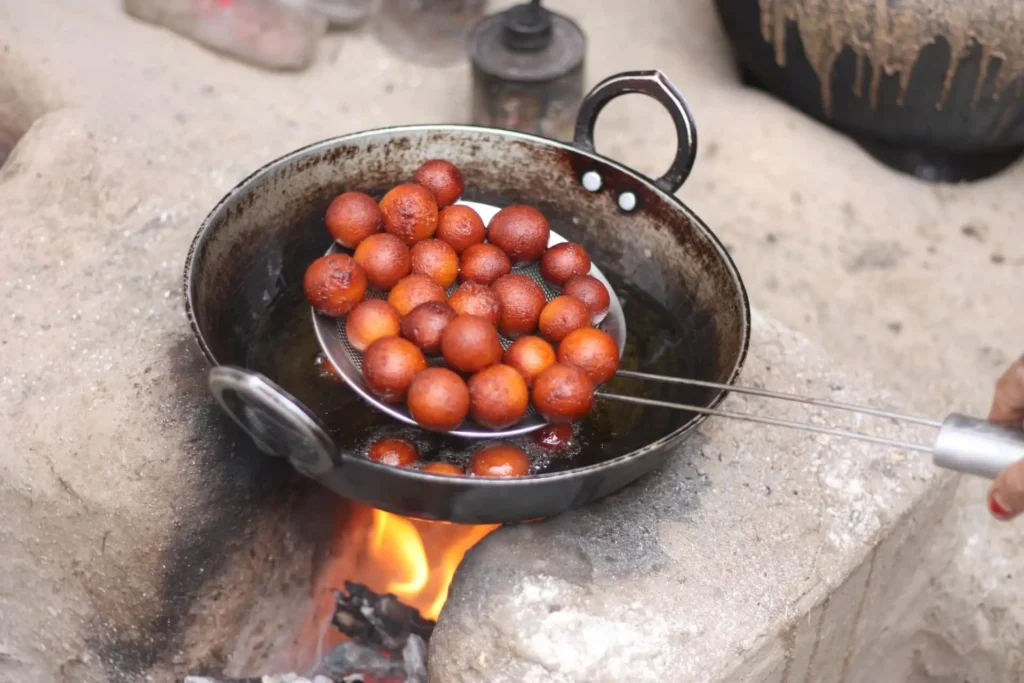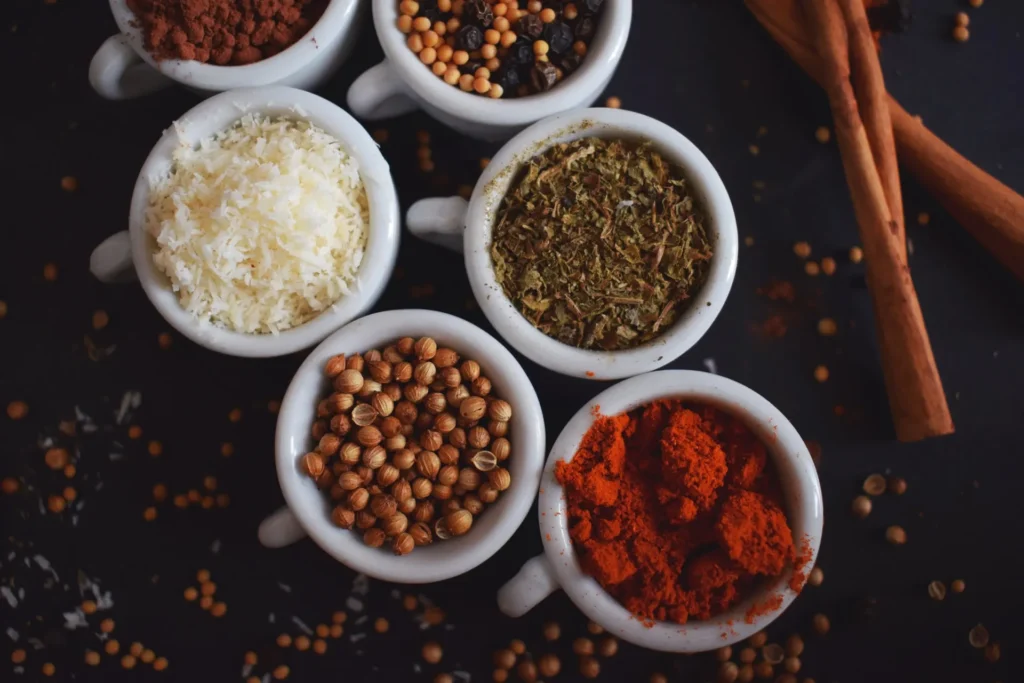India is a land of rich culinary diversity, where the flavors of India come alive and tantalize the taste buds. From the fragrant spices of the north to the coconut-infused dishes of the south, Indian cuisine offers a delightful array of flavors that are sure to satisfy even the most discerning foodie. In this article, we will take you on a mouthwatering journey through the different tastes and dishes that make up the vibrant tapestry of Indian cuisine
Indulge in the delightful diversity of Indian cuisine. Experience rich and spicy thalis in the north, subtle coconut-based flavors in the south, and feast on fresh fish curries at the coast. India, a foodie paradise, awaits your culinary exploration with our curated journey through favorite cuisines.
Food is a central activity of mankind and one of the single most significant trademarks of a culture.
Mark Kurlansky
The Six Flavors of Indian Cuisine
Indian cuisine is not just about the spices and ingredients used, but also about the balance of flavors. According to Ayurveda, the ancient Indian system of medicine, there are six primary tastes that should be present in every meal to maintain a healthy and well-balanced diet. These flavors are sweet, salty, sour, pungent, bitter, and astringent, embodying the holistic approach of flavors of India.
- Sweet: The sweet flavor is associated with foods that are naturally sweet, such as fruits, honey, and certain vegetables like sweet potatoes. It provides a sense of satisfaction and nourishment.
- Salty: Salt is a common flavor in Indian cuisine, enhancing the taste of dishes and balancing the other flavors. It can be found in various forms, including sea salt, rock salt, and black salt.
- Sour: Sour flavors add a tangy and refreshing element to dishes. They can be found in ingredients like lemon, tamarind, and yogurt. The sour taste stimulates digestion and helps in the absorption of nutrients.
- Pungent: Pungent flavors add a spicy and fiery kick to Indian dishes. They are often found in spices like chili peppers, ginger, garlic, and onions. Pungent flavors stimulate the senses and promote circulation.
- Bitter: Bitter flavors, such as those found in leafy greens like spinach and kale, as well as spices like turmeric, help in detoxification and digestion. They balance the heaviness of other flavors and promote a sense of lightness.
- Astringent: The astringent flavor is characterized by a dry and puckering sensation. It can be found in foods like cranberries, pears, and tea. Astringent flavors help in toning the tissues and balancing excessive moisture in the body.

Regional Variations in Flavor
One of the most fascinating aspects of Indian cuisine is its regional diversity, with each region having its own unique flavors and specialty dishes. Let’s explore some of the prominent regional flavors of India and delve into the rich tapestry of Indian regional cuisine.
North Indian Cuisine: Rich and Spicy
North Indian cuisine is known for its rich and indulgent flavors. The food of this region is characterized by the use of aromatic spices like cumin, coriander, and cardamom, which are key components of Indian spices. The curries are creamy and packed with flavors, often made with ingredients like paneer (Indian cheese), lentils, and meat. Some popular dishes from this region include butter chicken, biryani, and tandoori kebabs, all of which showcase the diverse flavors of India.
South Indian Cuisine: Subtle and Coconut-based
In contrast to the bold flavors of the north, South Indian cuisine is known for its subtle and delicate coconut flavors. Coconut plays a prominent role in the cuisine of this region, with dishes often featuring coconut milk, grated coconut, or coconut oil. Rice is a staple in South Indian meals, accompanied by dishes like dosas (rice and lentil crepes), idlis (steamed rice cakes), and sambar (a tangy lentil and vegetable stew), all celebrating the flavors of India.
Coastal Cuisine: Fresh and Seafood-centric
India’s extensive coastline is home to a vibrant seafood culture, with coastal cuisine offering an array of fresh and flavorful dishes that are a testament to the flavors of India. From the spicy fish curries of Kerala to the tangy shrimp dishes of Goa, coastal cuisine showcases the bounty of the sea. Coconut, tamarind, and a variety of spices are used to create dishes that are both aromatic and delicious.
East Indian Cuisine: Spicy and Flavorful
The cuisine of East India is characterized by its spicy and flavorful dishes. Bengali cuisine, in particular, is known for its use of mustard oil, panch phoron (a blend of five spices), and a wide range of seafood and freshwater fish. East Indian cuisine also includes dishes from states like Odisha and Assam, which feature unique flavors and ingredients like bamboo shoots and mustard greens, adding to the diverse flavors of India.

West Indian Cuisine: Tangy and Sweet
The flavors of India are vividly represented in West Indian cuisine, which is celebrated for its unique combination of tangy and sweet tastes. Gujarati cuisine, a gem of the West, is particularly renowned for its vegetarian dishes that masterfully blend sweet and savory elements. Maharashtra’s culinary offerings boast bold flavors, featuring spicy curries, tangy chutneys, and sweet desserts. Goa, the picturesque coastal state, is famous for its fiery spicy vindaloo and tangy fish curries that leave a lasting impression on the palate.
Must-Try Indian Dishes for Foodies
Having explored the diverse flavors of India, we now turn our attention to some quintessential Indian cuisine dishes that are a must-try for anyone looking to experience the full spectrum of these flavors:

Biryani: Aromatic and Flavorful
Among the iconic Indian rice dishes, biryani stands out with its rich and aromatic flavors of India. This classic dish layers fragrant basmati rice with succulent meat, typically chicken or mutton, along with a medley of spices and caramelized onions. The biryani is then slow-cooked or sealed in a pot, allowing the flavors to fuse into a mouthwatering symphony that is both delicious and aromatic.
Masala Dosa: Crispy and Spicy
The South Indian cuisine staple, masala dosa, is a delightful creation that marries a crispy rice and lentil crepe with a spiced potato filling. The dosa batter, a fermented mixture of rice and lentils, is spread thinly on a hot griddle to achieve its signature crispiness. The potato filling is a flavorful blend of spices such as mustard seeds, curry leaves, and turmeric. This flavors of India ambassador is typically accompanied by coconut chutney and sambar.
Butter Chicken: Creamy and Tangy
Butter chicken, or murgh makhani, is a beloved dish from North Indian cuisine, known for its creamy and tangy flavors. The chicken is marinated in a spiced yogurt mixture before being simmered in a rich tomato sauce with butter and cream. This indulgent dish, a staple of the flavors of India, is best enjoyed with naan or rice, making it a must-try for those who appreciate a velvety texture and rich taste.
Vada Pav: Spicy and Savory
Vada pav, Mumbai’s cherished Indian street food, is a testament to the spicy and savory flavors of Indian cuisine. This snack features a spicy deep-fried potato fritter (vada) nestled in a soft bun (pav), with the vada seasoned with a mix of chili, ginger, and garlic. The pav is generously coated with a tangy and spicy chutney, creating a burst of flavors and textures in every bite.
Chole Bhature: Tangy and Fried
Chole bhature, a celebrated dish from Punjabi cuisine, pairs spicy chickpea curry (chole) with fluffy deep-fried bread (bhature). The chole is simmered with a rich blend of spices, including cumin, coriander, and garam masala, while the bhature is crafted from fermented wheat flour dough. This dish, embodying the flavors of India, is often served with tangy pickles, cooling yogurt, and a side of onions and lemon wedges for an added zest.

Rasgulla: Sweet and Spongy
Rasgulla, a classic Indian sweet, is renowned for its sweet and spongy texture, making it a staple among the flavors of India. This delightful dessert is crafted by turning cottage cheese (paneer) into small balls, which are then simmered in a sugar syrup infused with cardamom. The outcome is a rasgulla that dissolves in your mouth, offering a refreshing yet indulgent experience.
Conclusion: Embark on a Flavorful Journey
The culinary landscape of India is a cornucopia of flavors, with each region presenting its own signature taste experiences. From the hearty and spicy curries of the north to the zesty and coconut-laden dishes of the south, Indian cuisine is an epicurean celebration. No matter if you’re a fan of fiery spices or have a palate for gentler flavors, Indian cuisine offers a myriad of options for every taste preference.
Thus, when you’re in India, make sure to embark on a culinary journey that will take you through the myriad flavors of India. Savor the fragrant biryanis, the crunchy dosas, and a plethora of other dishes that comprise this culinary paradise. Indian cuisine invites you to indulge in a gastronomic adventure, letting your taste buds revel in ecstasy!
FAQs:
- How important are the six flavors in Indian cuisine?
According to Ayurveda, the ancient Indian system of medicine, the six primary tastes—sweet, salty, sour, pungent, bitter, and astringent—are crucial for maintaining a healthy and balanced diet.
- What distinguishes North Indian cuisine from South Indian cuisine?
North Indian cuisine is known for its rich and spicy flavors, utilizing aromatic spices like cumin and cardamom. In contrast, South Indian cuisine is characterized by subtle tastes and often incorporates coconut in various forms.
- What role does coastal cuisine play in Indian gastronomy?
Coastal cuisine in India, influenced by the country’s extensive coastline, offers fresh and seafood-centric dishes. It features a blend of aromatic spices, coconut, and tamarind, showcasing the diverse bounty of the sea.
- Can you recommend a must-try dish from West Indian cuisine?
West Indian cuisine, known for its tangy and sweet flavors, offers delightful dishes. One must-try is the Gujarati cuisine from Gujarat, featuring sweet and savory vegetarian dishes.
- What makes masala dosa a South Indian specialty?
Masala dosa is a crispy and spicy South Indian delicacy that combines a rice and lentil crepe with a flavorful potato filling. It is a staple known for its unique preparation and delicious taste.
- Are there vegetarian options among the must-try Indian dishes?
Absolutely! Dishes like Masala Dosa and Chole Bhature are popular vegetarian options that showcase the diverse and flavorful range of Indian cuisine.

